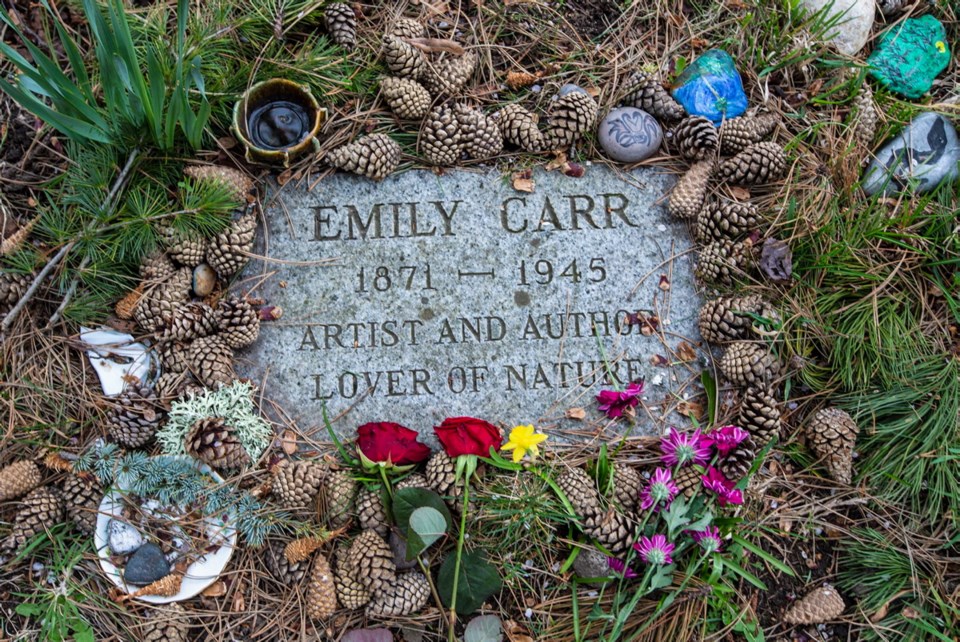This obituary of Emily Carr was published in the Victoria Daily Times, on March 3, 1945. We're republishing to mark the 75th anniversary of her death.
Emily Carr, noted Victoria-born author and painter, died at St. Mary’s Priory, Friday, at 3:45 p.m., after a week’s illness. The famous authoress, whose book, Klee Wyck, won the Governor-General’s award for non-fiction in 1941, had been in poor health for several years, but she continued her painting and writing until the last.
At her death, Miss Carr, who was 74, was working on canvases intended for an exhibition at the Vancouver Art Gallery next month. She said she felt she wanted to give one last exhibition of her work in British Columbia. In this exhibit she had planned to show a number of new pictures, on which she was working a few weeks before her last illness, as well as older sketches.
At the time of the publication of her last book, The House of All Sorts, on her 74th birthday, last Dec. 13, she announced that she intended to write a fourth book — “to be published after my death; I don’t want it in print until after I go.”
True picture of B.C.
Her first book, Klee Wyck, published in 1941, was, according to the Canadian Authors’ Association, the truest picture of any aspect of British Columbia to appear in print. This was followed by The Book of Small, a story of her childhood, and crowded with Victoria personalities of the 1880’s.
Miss Carr was born in Victoria Dec. 13, 1870, and was one of nine children. Her father, Richard Carr, came to the Pacific coast in the gold-rush days of 1849, and returned to England to marry.
When Emily was 12 years old her parents died, but her guardian allowed her to study art, and she attended the best schools in San Francisco, London and Paris.
However, she was not a traditionalist in art, and said at this time:
“I drew away from the old-school methods of teaching, realizing the cramped style of London and Paris could not adequately describe Canada.”
However, her ideas did not prove popular when she returned to Canada, and she was unable to make a living with her art. So she started what was politely called a “guest-house,” described vividly in The House of All Sorts. She also ran a kennel of English sheep dogs.
During this period, Miss Carr did little painting except on trips up the coast and to the Cariboo. The Indians welcomed her to their homes, even in remote districts where intruding white people were driven out, and gave her the name Klee Wyck, the Laughing One, to show their love for the woman who moved among them for half a century.
Montreal impressed
Eric Brown, director of the National Art Gallery at Ottawa, heard of her work and came to Victoria, selecting 17 canvases for the National Art Gallery. He was so impressed by the artist’s work that he urged her to continue, and today her paintings are in many art galleries throughout North America and in England.
Last winter her work was again exhibited in the East, this time at the Dominion Art Gallery, Montreal and was so successful the exhibition lasted two months.
Despite a stroke last October that affected the use of her left arm, Miss Carr continued to write and paint at her St. Andrew’s Street home, remarking dryly that the arm “makes an admirable paper weight.” Her fourth book will be published in a few months.
In commenting on Miss Carr’s death, Nellie McClung, Canadian writer, said: “Emily Carr was essentially a trail-breaker; she was not afraid to make a new pattern with her pen or a paint-brush. She was a shining link with the past, and had a wide circle of friends who will mourn her death. She wrote as she pleased and painted her world as she saw it. Let us hope that her mantle will fall on many of our younger writers who will carry on with diligence and courage for the enrichment of Canada’s cultural life.”
Her last days were spent in a one-story dwelling just behind the 80-year-old Carr family home with her sister, Miss Alice, now blind. Her studio was in the room where Alice formerly taught private school classes, and was crammed with canvases. The big main gate of the estate is closed, but signs directed traffic: “For Miss Alice Carr take the path to the right. For Miss Emily Carr take the gravel path to the left.”
The only surviving close relative is her sister, Miss Alice Carr. There are a number of nieces and nephews.



